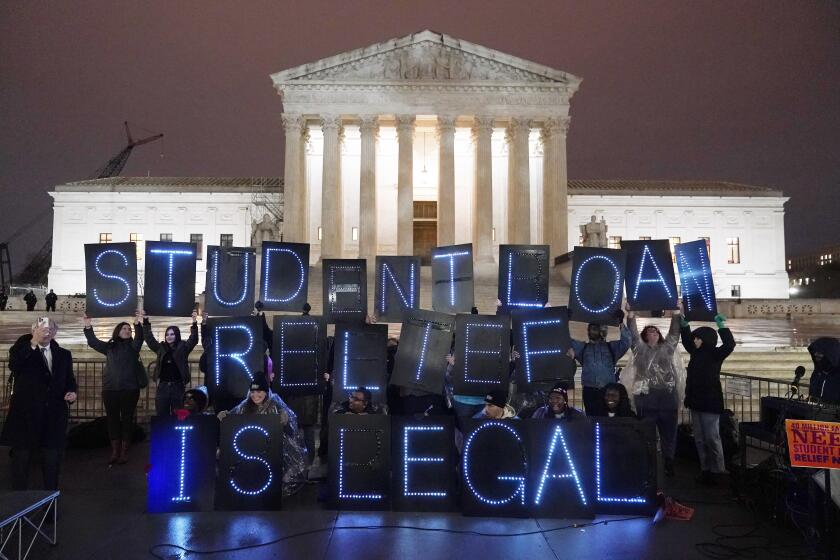Schools Drop Race Factor in Admissions
Race will no longer determine admissions to San Francisco schools, under a settlement reached by Chinese Americans with the school district and the NAACP and tentatively approved Wednesday by a federal judge.
U.S. District Judge William Orrick hailed all sides for working “night and day . . . to come up with a viable and useful and, at this stage, proper solution,” to a class-action lawsuit brought by three Chinese American families. He will hold a final hearing on the settlement April 20.
The families filed the suit, known as Ho vs. San Francisco Unified School District, in 1994. They alleged that their children were denied admission to prestigious Lowell High School because of their race, in violation of their 14th Amendment right to equal protection.
All parties said the settlement prevented a potentially divisive trial that would have brought racial tensions to the surface in a city that prides itself on its political liberalism and social tolerance.
“It pretty much would have pitted the Chinese students against other ethnic groups within the district” in an attempt to end racial quotas that were limiting the number of Chinese students in the district’s best schools, said Assistant Supt. Anthony Anderson.
The case has been closely watched across the nation by desegregation experts and anti-affirmative action forces. The district’s plan has long been considered a progressive model because it provides a multiracial definition of integration, recognizing nine racial and ethnic categories and requiring that at least four of them be present in each school.
But its racially based admission system was highlighted in the campaign for Proposition 209, the statewide initiative passed in 1996 that banned state and local affirmative action programs in public education, hiring and contracting.
The settlement “represents a real victory, not just for parents in San Francisco but for the state of California,” said University of California Regent Ward Connerly, who spearheaded the Proposition 209 effort and has campaigned for similar measures in other states. “My only regret is that this didn’t go all the way to the Supreme Court, so we could get a national decision once and for all that would put these sorts of practices to bed,” Connerly said.
Chinese Americans who participated in the lawsuit were jubilant after the hearing.
“This is the second day of the Chinese New Year and a new beginning for all children of San Francisco and Chinese Americans throughout the country,” said Amy Chang, a lawyer with the Asian American Legal Foundation. “Chinese Americans since the beginning of the Gold Rush in San Francisco have persisted and have flourished despite mountains of adverse legislation and laws.”
Peter Cohn, a lawyer for the National Assn. for the Advancement of Colored People, stressed that the settlement leaves in place most elements of a 1983 court-ordered desegregation plan that resolved an earlier discrimination lawsuit the NAACP brought against the district.
“The consent decree is alive and well,” Cohn said.
The new settlement eliminates racial quotas and bans the district practice of requiring parents to state their child’s racial or ethnic identity on admission forms. The quota system had placed a 45% ceiling on any racial or ethnic group at a neighborhood school, and a 40% ceiling at alternative or magnet schools.
The district “shall not assign or admit any student to a particular school, class or program on the basis of the race or ethnicity of that student,” the settlement says.
But it also says that the sides must negotiate a solution if “racial or ethnic concentration” occurs in any school as a result, without defining how large a predominance of any one ethnic group would be unacceptable. The settlement leaves in place court-ordered busing and a host of programs aimed at boosting the academic performance of underprivileged students.
It preserves the district’s eligibility for $37.6 million in federal funds to assist desegregation, and allows the district to continue to use race and ethnicity as one factor, although not a determining one, in its admissions policies until Dec. 31, 2002, Anderson said. The district will be able to redraw attendance boundaries and use nonracial factors such as family income, ZIP Codes and other data to achieve racial balance in the schools, he said.
Because the settlement was reached amid enrollment for the 1999-2000 academic year, it will not be fully implemented until the 2000-01 academic year, Anderson said.
Chinese Americans are the single largest ethnic group in the district--28% of the student body--and regularly hit the ceiling in the competition to get into desirable schools. Because neighborhood schools often have poor test scores, competition is fierce for so-called alternative schools that offer special programs.
“I went through the emotional turmoil about five years ago,” said Jane Chen, one of the plaintiffs in the case. Chen’s daughter, who is Chinese, applied to Lowell High and was turned down because there were too many Chinese students in the school. At the time, Lowell required Chinese students to score higher on its entrance exam than whites and other ethnic groups. The district stopped holding Chinese American students to that higher standard at Lowell three years ago.
The settlement was reached Tuesday, the day the case was due to go to trial, after marathon negotiations that involved lawyers for the district, the Chinese Americans, the NAACP and the office of the state superintendent of public instruction.
“This settlement is consistent with the San Francisco tradition of people trying to work together,” said Daniel Girard, the lead attorney for the Chinese Americans.
“No one will be told what one of our plaintiffs was told: that her son could not attend a school because there were too many Chinese,” a tired but visibly pleased Girard said after the hearing. “And no parent will be compelled to identify their child on the basis of race or ethnicity. . . . We view this as a superlative outcome.”
More to Read
Sign up for Essential California
The most important California stories and recommendations in your inbox every morning.
You may occasionally receive promotional content from the Los Angeles Times.






